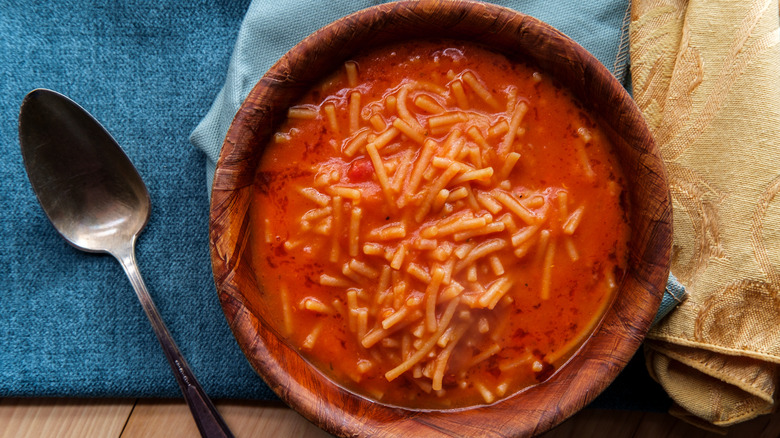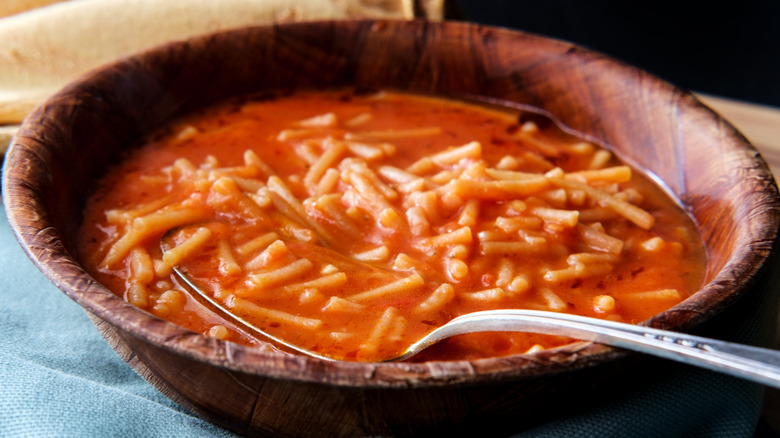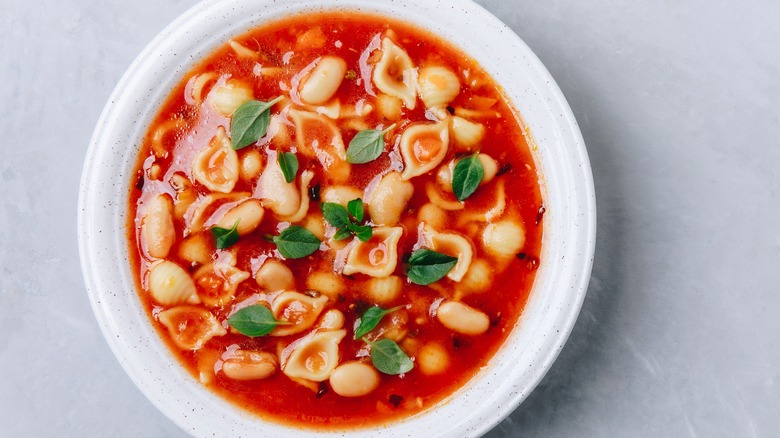What Is Sopita And What Does It Taste Like?
Sopita cradles chewy pasta shells in a broth bursting with bright tomatoes and cozy chicken broth. Its warm and comforting flavor reminisces the fuzzy feeling you get from a well-made macaroni and cheese. In Spanish, sopita translates to soup, and it's typically served in Mexican and Spanish cuisine. Recipes for sopita vary and may be personalized in a number of ways. But at its essence, this dish is a pasta noodle soup.
In its most basic form, sopita is made from chicken broth, tomato sauce, olive oil, seasoning, and pasta. These are standard ingredients, but the sweet zing of the tomatoes, melding with the meaty chicken broth, creates an inviting and delicious dish. Variations of sopita include sopita de coditos, sopita de fideo, sopita de conchas, and sopita de letras. These refer to the type of pasta shape used in the recipe. However, it's common to see the term "sopa" referring to sopitas recipes, too.
While there are some common misconceptions about Mexican food, it's equally important to highlight that Mexican cuisine holds a wealth of untapped possibilities. Begin your exploration with sopita and discover what culinary horizons it may broaden.
Sopita origins
While the history of Mexican cuisine dates back to 7000 B.C., sopita actually originates from very different shores. Pasta is believed to have roots in central Asian cuisine, where it is believed to have been introduced to Italy and Spain by Arab explorers. Another theory suggests Marco Polo brought it over from China during the 13th century. Still, evidence indicates it was popular in Europe long before this time, during the 8th and 9th centuries. Sopita then emerged as a popular Spanish dish eaten throughout the country.
Fast-forward to the 1600s, and during Spain's colonization of the Philippines and Mexico, this dish became a popular part of both cuisines. This dish has evolved over the centuries to become what it is today. Initially, the sopitas recipe involved adding pasta towards the end of the cooking process, similar to the Filipino variation of sopas (chicken macaroni soup). This prevents the pasta from absorbing too much liquid and losing any bite.
Mexican sopita, however, typically involves browning the pasta at the start before adding any liquid ingredients. This allows the pasta to retain that chewy bite without losing its texture and turning soggy in the broth. Alongside this, the Mexican sopitas recipe is flexible and diverse, with room for different herbs, vegetables, meats, and toppings.
The taste break down
With chewy pasta shapes, hearty chicken broth, umami tomatoes, and bright spices, sopita's taste should capture the essence of comfort. A hug in a bowl, sopita is a dish you crave when you're sick or on colder days when you need a little lift. To capture this taste, it's essential to slightly brown the pasta and toast any spices first. This means the pasta will have that firm texture, and the broth will be fragrant with all those beautiful spices.
You may also recognize that other pasta shapes can be used, such as letras (alphabet pasta), fideo (cut spaghetti), or conchas (shells). These will change how the soup tastes and could add a grainier flavor. The flexibility of Sopita's recipe also allows you to include different vegetables which add other flavors, such as tangy onions or sweet bell peppers. Extra meat, such as ground beef or chicken, can also add protein and accentuate the meatiness of the broth.
In terms of seasonings and herbs, think tangy garlic powder, fresh peppery cilantro, nutty ground cumin, earthy oregano, or spicy dried red chilies. Sopita can even be topped with cheese or a dollop of sour cream if you desire a creamy element, too. For all its deliciousness, it's time to welcome the wonderful flavors of sopita into your life and try it either in the kitchen or the next time it crosses your path.


